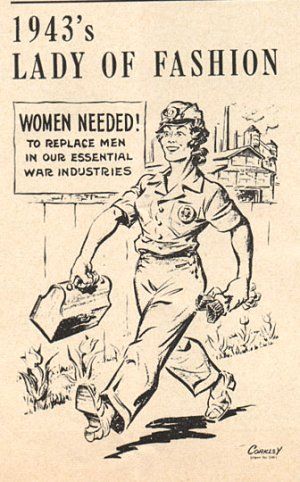In assessing the possibility that a severe downturn occurred at the end of WWII, I took issue with conventional wartime and postwar output statistics, while taking the period’s unemployment statistics at face value. In so doing I set aside a hypothesis that disputes the unemployment numbers themselves. According to it, large numbers of would-be wartime women workers left the labor force not because they didn’t want to keep working, but because they faced impossible odds of staying employed. If that was the case, then official figures substantially understate the real extent of unemployment, and whatever actual U.S. postwar output was, it was well below its potential.
Frances Copolla has recently stated and defended the hypothesis in question with great vehemence. “There was never full employment,” she says. “The low unemployment of the post-war years is a massive statistical fudge. In fact, over five million people lost their jobs immediately after the end of the war, most of whom never worked again. But they were never listed as unemployed—because they were women.”[1]
In defending this claim, Copolla takes the accuracy of conventional wartime and postwar output measures for granted. “The fall in real GDP in 1945-46,” she says, “dwarfs both the Great Recession and the Covid-19 recession. Only the Great Depression was worse.” Observing, further, that it “is extremely odd for unemployment to be so low in a recession of such severity,” she concludes, not that the output statistics themselves are suspect, but that the unemployment figures are: those figures were low, she says, only because they excluded millions of discouraged women workers. “Faced with discrimination, harsh pay cuts, and unfair job downgrades,” she says, “many women did indeed opt to leave the workforce. But it is hard to see how dropping out of a labour market that did not want them and was determined to push them out is in any way ‘voluntary’.” Had these discouraged women been included among the unemployed, postwar unemployment rates might have been twice as high as those actually recorded.
Veterans and Interlopers
As we’ve seen, it’s more than a little dangerous to infer the “true” extent of postwar unemployment from official output measures. The fact remains, however, that the total (civilian and military) labor force shrank considerably between mid 1945 and mid 1946, and that much of that decline was due to women workers’ withdrawal. Discrimination against women workers, and in favor of returning (mostly male) war veterans, during the postwar reconversion was also both very real and widespread.
The federal government itself was no small culprit. The 1940 Selective Training and Service Act gave returning servicemen who quit their jobs to serve the right to demand those jobs back provided they applied within forty days of being discharged (Ballard, 1983, p. 45). That step alone gave some 4 million returning servicemen first dibs on as many jobs. Nor did it help that the U. S. Employment Service (USES), which operated a network of government-employment placement offices during and immediately after the war, gave priority to veterans as soon as the war ended—though it must be said that it did so in large part because hiring firms themselves preferred them (Rose 2018, p. 31). Finally, the Federal government itself dispensed with many of its wartime female non-military workers, the number of whom fell from a peak of about 1.1 million to less than half a million by 1947 (U.S. Dept of Labor, 1953, p. 30).
With a few (mostly left-wing) exceptions, labor unions were also notorious discriminators. According to Colston Warne (1945, p. 203), rather than “accord women an equal place in their works,” they tended to look upon them “as interlopers and ‘wage cutters’ who undermined union standards.” Consequently, Alice Kessler-Harris (1982, p. 291) reports, despite the fact that more than three million women workers made up 22 percent of trade union membership in 1944—up from just 800,000 when the war started—”most unions unceremoniously discarded their female members at war’s end.”
But the prejudice against women workers, and in favor of veterans, wasn’t simply a matter of misogynistic bureaucrats and unions. Instead, as Warne (1945, p. 203) relates, it reflected “the mood of the nation,” informed both by a desire to reward war veterans for their sacrifices and by an “archaic attitude toward the place of women in industry” that was far from being confined to men alone.
It’s also true that millions of women workers were laid off during demobilization, and that millions left the labor force, including more than half of the 2.7 million married “Rosies” (after “Rosie the Riveter”) who entered it during the war, and who were especially likely to be sacrificed to make way for returning veterans (Goldin 1991, p. 750). In all, roughly five million women had joined the labor force during the war. Because roughly a quarter million left during it, the net gain between March 1940 and April 1945 was about 4.75 million. Although most working women expressed a desire to keep on working after the war, between then and 1947 the female force declined by 3.25 million, of whom some 520,000 only were officially considered “unemployed” (U.S. Dept of Labor, 1953, p. 6, Table 2, and p. 35, Table 14). Considering the severe discrimination they faced, it’s easy to imagine that many, if not most, of the remaining 2 million or so left the labor market not because they wanted to but because they understood that employers no longer wanted them.
A (Slightly) Rosier Picture
And yet, despite all these indisputable truths, the discouraged women workers story, understood to mean that millions of women left the labor force involuntarily as the armed services demobilized, doesn’t bear scrutiny.
To understand why, it helps, first of all, to appreciate the extraordinary lengths to which the government went to coax extra women into the labor force during the war. In mid-1943, the War Manpower Commission concluded that keeping the war industries working at full capacity would take another 4 million women workers, and that, with most single women already working, many married women would somehow have to be lured into the workforce. By appealing to non-working women’s patriotism (Lepp 1978, chapter 6), but mostly by offering them extraordinarily high pay (Schweitzer 1980), the Commission managed to attract even more new women workers than it tried for. The vast majority only intended at first to work “for the duration,” on the understanding that the end of the war would restore the labor-market status quo ante. As the war wore on, some changed their minds. But on the whole they remained far less intent on continuing to work when peace returned than women who had already been working before Pearl Harbor.
It’s seldom possible to say for certain whether women who leave the labor force have done so voluntarily or not; and that was especially so before 1967, when the Bureau of Labor Statistics first started asking non-working women why they weren’t working or seeking work in its monthly Current Population Survey.[2] It so happens, however, that in 1944 and 1945 two separate Labor Department bureaus conducted special surveys that, when taken together, come as close to supplying an answer as one could dare to hope.
One of those surveys, by the Woman’s Bureau, found that, of over 13,000 women workers surveyed in 10 major “war production centers” during 1944 and early 1945, 25 percent, including many of the married “Rosies” who entered the labor force during the war, didn’t wish to continue working after it. Those who wanted to stay employed, in contrast, were for the most part “not those who had been swept into the labor force during its wartime expansion.” The other survey, conducted by the BLS, was based on interviews of 5,100 women working in the spring of 1945, 3,600 of whom were resurveyed that winter. By then almost all of the War Department’s contracts had been terminated, most war factories and shipyards had either permanently shut down or were undergoing reconversion, and more than 2 million women war workers had been laid-off (Ballard 1983, pp. 135-6). Like its Women’s Bureau counterpart, the spring BLS survey found that 25 percent of surveyed war-industry workers including, once again, a disproportionate number of married ones, planned to leave the labor market when the war ended. The winter follow-up discovered in turn that 29 percent of those resurveyed had actually left, and that most were married.[3] In contrast, the BLS found that only 5 percent of non-war industry women workers surveyed in the spring were planning on leaving the labor market after the war, and that precisely that share had in fact left it by October.
Assuming that the war-industry women surveyed by the Women’s Bureau were representative of the 4.6 million women employed in 1945 as “operatives and kindred workers,” meaning most semi-skilled factory workers, many of whom were then producing munitions, aircraft, ships, and other war materiel, some 1.15 million women operatives were planning to leave the labor force months before any mass layoffs occurred.
In fact, between 1945 and 1947 the number of women operatives fell by 1.2 million, implying, once again, that just 4 percent were let go who hadn’t planned to leave the workforce. Allowing that nearly 14.6 million women were working in non-war-related industries in the spring of 1945, and that 5 percent of those women also planned to leave the labor force when the war ended, that brings the total planned women’s labor-force reduction to just under 2 million. According to The Eighth Report of the Office of War Mobilization and Reconversion, (1946, p. 59), between August 1945 and February 1946, total non-farm employment of women actually fell by 2,210,000, half a million of whom were among those counted as unemployed at the end of that stretch.[4] Provided one trusts them, while assuming that women who were planning to leave the labor force months before V-J Day left voluntarily, these numbers leave no room at all for any discouraged women workers!
Furthermore, quite a few unplanned labor-market departures were themselves voluntary: the extraordinary number of spur-of-the-moment engagements that took place as soon as troops started coming home caused almost as many formerly working single women to become housewives—and mothers. According to Cynthia Harrison (1989, p. 25), “No one had to force women into marriage and motherhood. The marriage rate, 84.5 per thousand women in 1945, shot up to 120.7 in 1946 and 106.8 in 1947; fluctuating between 78 and 98 per thousand for the next ten years.” 1946, the first year of the “baby boom,” witnessed 1,340,504 first births—a record number (Federal Security Agency 1949, p. xxiv). [5]
Marc Miller (1980, pp. 80-81) has looked into the specific case of women workers in Lowell, Massachusetts, where several war-based businesses, including Remington Arms, U.S. Rubber, and the Atlantic Rayon Company’s Parachute Division relied heavily on women workers either newly recruited to the workforce or hired away from textile mills that had been the town’s main employers before the war. What he reports seems quite consistent with these back-of-the-envelope results. “There seems to have been little complaint,” he says,
about having men return home and resume the old economic hierarchies. … Some Lowell women gladly left their work after their husbands returned and found employment; these women had seen work only as an option “for the duration.” Others left as the postwar baby boom began. As one women recalled, she had intended to find work in Lowell after her government office closed, but found herself “in the family way” and didn’t return to work.
Of course many former war workers who wanted to keep working also found themselves without jobs. But other “work existed for most of the women who sought it, albeit at lower wages” (ibid, p. 59).
Does this mean that most laid-off women workers weren’t victims of discrimination after all? Hardly. First of all, it’s possible that at least some of the women who were planning to quit working months before the war ended planned to do so only because they knew that discrimination would make their postwar job prospects extremely dim. I say that it’s possible. But it’s not very likely, for in general would-be workers become discouraged only after losing their jobs. Furthermore, most do so only after being (officially) unemployed for some time, and particularly after they become ineligible for unemployment compensation. As the Bureau of Employment Security’s Olga Halsey (1946, p. 7) put it in June 1946, “unemployment is the winnowing process by which many ultimate withdrawals from the labor force will be accomplished”:
Many of those who find they cannot get the type of work they want or for which they are qualified by their wartime experience, at wages which compare favorably with wartime earnings, will give up the effort sooner or later. …As the length of unemployment increases, more marginal workers will withdraw.
Halsey herself worried that the women’s labor force would continue to shrink as more unemployed women workers became discouraged and quit searching for jobs. But that never happened. Instead, the women’s labor force started growing again. Sometime in 1951, it was back at its wartime peak, which it went on to surpass.
It was mainly women who never left the labor force, most of whom were adult women who’d been working before Pearl Harbor, who turned out to be discrimination’s biggest victims. Most of these women needed to keep working to support themselves, if not their dependents. After reviewing numerous Women’s Bureau surveys of wartime women workers, Mary-Elizabeth Pidgeon (1952, p. 71) concludes that it’s probably “conservative to say that at least half this country’s women workers consider themselves responsible for the entire or partial support of others, in addition to self-support.” Because they couldn’t afford to quit working, they suffered not by leaving the labor market but by being temporarily (officially) unemployed, and, like some former women war workers in Lowell, by accepting jobs that paid much less, and were often less satisfying in other ways, than those they had before. As Sheila Tobias and Lisa Anderson put it, in their important 1974 study, “What Really Happened to Rosie the Riveter?,” “Rosie stopped riveting, but she did not stop working” (Kossoudji and Dresser 1992, p. 434). More accurately, she didn’t stop working, unless she didn’t have to.
Continue Reading The New Deal and Recovery:
Intro
Part 1: The Record
Part 2: Inventing the New Deal
Part 3: The Fiscal Stimulus Myth
Part 4: FDR’s Fed
Part 5: The Banking Crises
Part 6: The National Banking Holiday
Part 7: FDR and Gold
Part 8: The NRA
Part 8 (Supplement): The Brookings Report
Part 9: The AAA
Part 10: The Roosevelt Recession
Part 11: The Roosevelt Recession, Continued
Part 12: Fear Itself
Part 13: Fear Itself, Continued
Part 14: Fear Itself, Concluded
Part 15: The Keynesian Myth
Part 16: The Keynesian Myth, Continued
Part 17: The Keynesian Myth, Concluded
Part 18: The Recovery, So Far
Part 19: War, and Peace
Part 20: The Phantom Depression
Part 20, Appendix: The Fate of Rosie the Riveter
_____________________
[1] The particular object of Copolla’s remarks is a 2010 Cato Institute Policy Report by economic historians Richard Vedder and Jason Taylor, whose claims she attributes to “the Cato Institute.” In fact, Vedder and Taylor are academics unaffiliated with Cato, both of whom have written extensively on labor market developments during and after the Great Depression. More importantly, their claims about post-WWII unemployment, far from involving “blatant misrepresentations of the unemployment figures,” as Copolla claims, are ones shared, rightly or wrongly, by almost all economists and economic historians, including those who once forecast high postwar unemployment. Hence the voluminous literature endeavoring to account for how those forecasts went wrong. For this reason, Copolla’s singling-out of Vedder and Taylor’s essay for vilification would be unfair even if her criticisms of it were correct.
[2] Despite the fact that the BLS had by then been producing regular estimates of the number of discouraged workers for a decade, in 1979, after a close vote, the National Commission on Employment and Unemployment elected not to consider such workers unemployed, on the grounds that they showed no “distinctive attachment to the work force” (Finegan 1981, p. 88).
[3] 29 percent is the value reported in the BLS survey’s Table 1. Elsewhere (p. 5) it says that only 28 percent of surveyed women workers left the labor force. Because the higher figure is slightly more favorable to the discouraged worker hypothesis, I’ve chosen to rely on it.
[4] The main reason for setting women farm workers aside is that farm labor is highly seasonal, with its peak in the summer and autumn. Because February is in the low season, including them would increase the number of women who left the labor force during the period in question, which ends during a lull in farm activity, by at least another 800,000, even though these women would normally rejoin the labor force several months later. Furthermore, besides those directly hired by farmers, 1.5 million wartime women farm workers were volunteers serving in the Women’s Land Army and other emergency programs set-up to recruit replacements for drafted male farm workers. Though practically all of them exited the labor force after the war, there’s little reason to suppose that any did so involuntarily, for such volunteers had no reason to continue working then: unlike the case for “Rosies” who entered the workforce to take advantage of high-paying manufacturing jobs usually reserved for men, patriotism, rather than economic incentives, was “the primary reason women enrolled for farm work” (Rasmussen, 1951, p. 143).
[5] According to John Modell (1989, pp. 173, 120), even during the war marriage “was an important cause of attrition from the labor force among single women,” despite the fact that many waited until the war was over to have children. Consequently, besides leading to a burst of marriages, demobilization led to a still larger burst in new family formation. As Hugh Rockoff notes (2000, p. 98), the high 1946 birth rate is itself evidence that the U.S. economy wasn’t depressed then, for despite postwar euphoria, men and women continued to consider the prospects for economic security and adequate real earnings in deciding whether or not to have children.
The post The New Deal and Recovery, Part 20, Appendix: The Fate of Rosie the Riveter appeared first on Alt-M.






